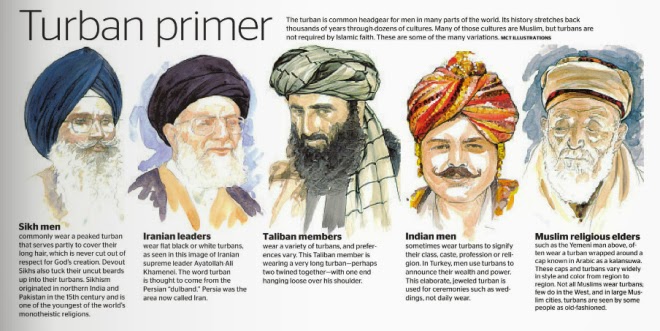Sikh men commonly wear a peaked turban that serves partly to cover their long hair, which is never cut out of respect for God’s creation. Devout Sikhs also do not cut their beards, so many Sikh men comb out their facial hair and then twist and tuck it up into their turbans along with the hair from their heads. Sikhism originated in northern India and Pakistan in the 15th century and is one of the youngest of the world’s monotheistic religions. There are an estimated 18 million Sikhs in the world, with some 2 million spread throughout North America, Western Europe and the former British colonies.
Muslim religious elders, like this man from Yemen, often wear a turban wrapped around a cap known in Arabic as a kalansuwa. These caps can be spherical or conical, colorful or solid white, and their styles vary widely from region to region. Likewise, the color of the turban wrapped around the kalansuwa varies. White is thought by some Muslims to be the holiest turban color, based on legends that the prophet Mohammed wore a white turban. Green, held to be the color of paradise, is also favored by some. Not all Muslims wear turbans. In fact, few wear them in the West, and in major cosmopolitan centers around the Muslim world, turbans are seen by some as pass.
Afghan men wear a variety of turbans, and even within the Taliban, the strict Islamic government that controls much of the country, there are differences in the way men cover their heads. This Taliban member, for example, is wearing a very long turban – perhaps two twined together – with one end hanging loose over his shoulder. The Taliban ambassador to Afghanistan, on the other hand, favors a solid black turban tied above his forehead. And some men in Afghanistan do not wear turbans at all, but rather a distinctive Afghan hat.
Iranian leaders wear black or white turbans wrapped in the flat, circular style shown in this image of Iranian supreme leader Ayatollah Ali Khamenei. The word turban is thought to have originated among Persians living in the area now known as Iran, who called the headgear a dulband.
Indian men sometimes wear turbans to signify their class, caste, profession or religious affiliation – and, as this man shows, turbans in India can be very elaborate. However, turbans made out of fancy woven cloths and festooned with jewels are not unique to India. As far away as Turkey, men have used the headgear to demonstrate their wealth and power.
The kaffiyeh is not technically a turban. It is really a rectangular piece of cloth, folded diagonally and then draped over the head – not wound like a turban. Yasser Arafat, the Palestinian leader, has made the kaffiyeh famous in recent times. However, the kaffiyeh is not solely Palestinian. Men in Jordan, Saudi Arabia and the Arab Persian Gulf states wear kaffiyehs in colors and styles that are particular to their region. Jordanians, for example, wear a red and white kaffiyeh, while Palestinians wear a black and white one. And a man from Saudi Arabia would likely drape his kaffiyeh differently than a man from Jordan. The black cord that holds the kaffiyeh on one’s head is called an ekal.
Desert peoples have long used the turban to keep sand out of their faces, as this man from Africa is likely doing. Members of nomadic tribes have also used turbans to disguise themselves. And sometimes, the color of a person’s turban can be used to identify his tribal affiliation from a distance across the dunes. This man’s turban is a very light blue. In some parts of North Africa, blue is thought to be a good color to wear in the desert because of its association with cool water





